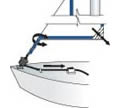Furling setup
A well set up furler is a joy to use, but there are ways and means of making any furler, Harken or otherwise, perform just that little bit better. Here are a few tips to get the best out of your furler:
A well set up furler is a joy to use, but there are ways and means of
making any furler, Harken or otherwise, perform just that little bit
better. Here are a few tips to get the best out of your furler:
1) Fit a ratchet block on the furling line lead into the cockpit. This
acts as a brake on the line, especially when unrolling the sail.
Imagine the scenario, you are clearing the harbour on a breezy day and
want to leave a few rolls in. You give a tug on the jib sheet and
suddenly the wind catches the sail and whammo – it is fully out, the
boat is on her ear and your tea is in your boots! A ratchet block only
rotates one way and thus gives you control on the line going out.
Kinder on the fingers too! 2) A tight forestay not only improves your
windward performance but also makes a furler easier to rotate. Also, a
sagging forestay will add fullness and thus generate weather helm
making control just a bit harder. Next time you are sailing on the wind
check for excessive forestay sag by looking up the forestay. If you
have a spare halyard, attach it to the stemhead, pull it tight and you
will have something to compare against. The Harken furler has built in
adjustment that can remove that. Alternatively you can increase your
backstay tension. Remember sag can also come from the mast tip falling
off to leeward, so the shrouds might need taking up a bit too. Also
consider there can be bed-down stretch in new rigging over a season so
even new boats can do with a check. If in doubt take a selection of
digital photos and ask a competent rigger to tune your rig up. It can
be surprising how it can improve rolling the sail up, plus you gain
control and improve performance. 3) Make sure your top swivel is as
high a possible. If you have a short luff sail with a long exposed
halyard, you run the risk of a halyard wrap, even with the very best
furlers. One solution is to fit a strop between the head of the sail
and the top swivel. That means the exposed halyard will be minimised.
The easy way of checking this is on a calm day, in dock, unroll the
sail, release the tack and see if you can hoist the sail further so
that the top of the swivel is as high as possible. You shouldn’t be
able to raise it more than around 6″ -150mm. (Check with a pair of
binoculars.) If it is more than that, measure the distance between the
bottom of the raised sail and the original tack position. That is the
length of your strop (best make it a little shorter to allow for
stretch.) Drop the sail, fit the strop between the head and the top
swivel, re-hoist with the sail tacked down as per usual. That way you
can get the swivel as high as possible and minimise the risk of halyard
wraps.
Read Harken’s Furling FAQs









